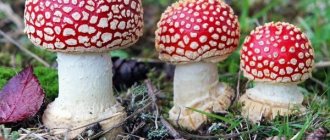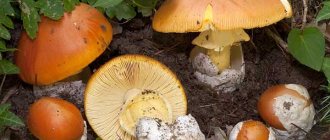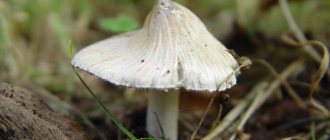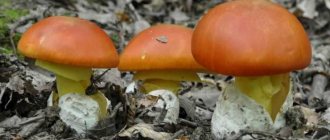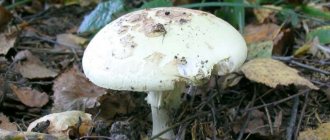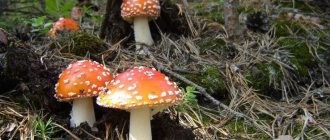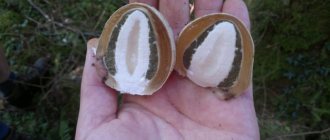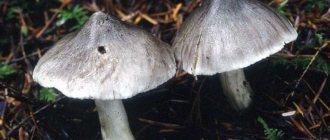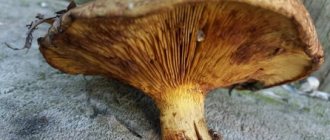Some types of fly agarics are edible and even tasty, this has long been no secret. However, do not even try to taste this variety - it is fraught with death!
The panther fly agaric fully justifies the bad reputation of the fly agaric family - its pulp contains a whole bunch of various toxins, ranging from muscarine, common to fly agarics, and ending with scopolamine, characteristic of dope and henbane.
Most of these toxins are not removed from the pulp during cooking, even for the longest time, and muscarine even enhances its toxic properties. The consequences of consuming panther fly agaric can be tachycardia, hypotension, collapse, suffocation, hallucinations and a whole range of other symptoms, any of which can lead to tragedy. The mushroom is extremely poisonous!
What does a panther fly agaric look like?
Panther fly agaric is considered a kind of younger brother of the entire variety of these mushrooms. However, it does not have such an attractive characteristic appearance as other species. In this regard, it is sometimes confused with other types of mushrooms that are quite edible. It is especially easy to confuse it with edible mushrooms at the very beginning of growth, so before you go picking mushrooms, you need to thoroughly study the characteristic features of this fly agaric in order to distinguish it.
The main shade of the cap of this fly agaric is olive, which often leads to it being confused with edible mushrooms. In general, depending on the age of the mushroom, the color of the cap varies from light green to brown. In addition, completely inexperienced mushroom pickers sometimes confuse young panther fly agarics with boletus and milk mushrooms.
The pulp is white; when cut, it remains white, but is not noticeably watery. The pulp is very fragile and breaks easily, has an unpleasant odor, like most fly agarics, and a sweetish taste. There are many petals, they are white, never grow to the stem and sometimes have brown spots, especially in old mushrooms.
The leg of a fly agaric, depending on its age, ranges from 4 to 12 cm in height, thin, usually about a centimeter in diameter. The leg tapers slightly at the top and forms a characteristic tuber at the bottom, empty inside. On the surface of the leg you can see a characteristic white pile; the ring is located very low or sometimes absent altogether. This species is often confused with the edible fly agaric, gray-pink.
The fly agaric reproduces by spores, feels great next to many trees and is found in almost all forests: deciduous, coniferous and mixed. Most often it is noticed growing under oak and pine trees; for growth, the mushroom prefers soil in which there is a lot of alkali. This species is most widely distributed in the Northern Hemisphere; it prefers a temperate climate without heat or severe frost. The growing season is mid-summer and ends around mid-September. In those places where the panther fly agaric grows, there are never any insects, since they all die only from the smell of this mushroom.
What other ways are there to dry mushrooms?
If it is not possible to dry mushrooms in any other way, you can dry them in the oven.
Fly agarics are cleaned of pine needles, sand and other impurities. There is no need to wash, as this will introduce a lot of moisture into the raw material. Prepared plants are laid out on a grid. If you dry on a baking sheet, the water generated during drying can ruin everything.
You need to start drying at a low temperature, 50 degrees. After two hours, when the plants have dried, the temperature can be increased to 70 degrees. After 2 hours, reduce it again to 50 degrees and hold for another 2 hours. For effective drying, ventilation is necessary, so the oven door should be slightly open to the width of your palm.
Mushrooms will be dried out if they become brittle.
These plants can also be dried in the sun if it is warm enough. To do this, the raw materials are strung on a strong thread and hung in the sun. There should be gaps between individual pieces. To protect against flies, you need to cover it with gauze. If the weather is hot, the mushrooms will dry out within a week.
Fly agarics can also be dried using an electric dryer. The mushrooms need to be arranged as shown in the picture.
Only instead of porcini mushrooms there will be fly agaric caps. This option is the simplest. All you have to do is set the time and temperature and the job will be done.
The caps are dried over a gas stove in the same way as over an electric stove, only the threads with raw materials need to be hung higher, away from the flames of the burners.
There is another option in which a Russian stove is used. The oven heats up well. Then a lattice is installed there, and fly agaric caps are placed on it. At first glance, everything is like in an oven, but good natural ventilation allows you to get a higher result in the quality of the final product.
The question arises. Why do people collect and store these poisonous plants?
In order to understand why people spend so much time collecting and preparing these plants, you need to understand in more detail their healing properties and how a person can benefit from their use and even get acquainted with some recipes.
But first you need to decide for whom these plants are contraindicated.
Medicines using these plants should not be used by pregnant women or nursing mothers. People who have individual intolerance. Children under 16 years of age. When taking medications from these plants, the dosage must be strictly observed.
The most medicinal species of these plants are panther and red fly agarics. These species have healing properties that are indispensable to any other plants. With the help of the panther species, venous and vascular diseases are treated, you can get rid of atherosclerosis and impotence. Infusions from this plant can get rid of warts.
Red fly agaric even treats epilepsy. Medicines from this plant successfully fight skin diseases and even pathologies in the spinal cord. Remedies from this plant eliminate ulcers and old ulcers, eliminate nervous breakdowns.
The danger of the panther fly agaric
This mushroom is extremely poisonous, like many other varieties of fly agarics, and contains the toxins hyoscyamine, muscarine, and scopolamine. The same toxins characteristic of henbane are found in dope and some other types of poisonous plants.
The panther fly agaric is much more poisonous than the red fly agaric. In addition to the already mentioned toxic substances, it also contains some specific substances that quickly enough cause complete paralysis of smooth muscles in the human body. In addition, it contains hyocyamine, which is mainly responsible for the death: it acts so quickly and strongly that no one survives serious poisoning.
This toxin paralyzes the respiratory center as well as the cardiovascular system, leading to cardiac arrest and complete inability to breathe. When this toxin enters the blood, it instantly coagulates, and all muscles cramp.
It is believed that panther fly agaric, when poisoned, primarily causes attacks of aggression in humans, along with an influx of strength and energy. There is a story that in the Russian army, soldiers were specially given panther fly agaric before battle in order to stimulate their fighting qualities and relieve them of fear. This effect is followed by hallucinations, and in cases of severe poisoning, the person loses consciousness, falls into a lethargic sleep or coma, which can be fatal.
Use
Panther fly agaric is EXTREMELY POISONOUS!
Some experts claim that this type of fly agaric is even more toxic than the pale grebe. This is due to the fact that the flesh of the panther fly agaric contains not one, but a whole group of different toxins with a wide spectrum of action. If you consume it, IMMEDIATELY rinse the victim’s stomach and call emergency medical help - Read more in our other article: All about mushroom poisoning: symptoms, signs, first aid
The benefits of fly agarics
Despite the fact that mushrooms of this species contain a large amount of toxic substances, certain types of fly agarics are used to produce medicines or for economic purposes.
- These mushrooms are used to get rid of insects, which is how they get their name.
- Some mushrooms contain a special substance that is used as one of the ingredients to create a medicine that has antitumor activity.
- Ancient peoples used fly agarics in small quantities to induce hallucinations; it was a necessary part of rituals and ceremonies.
- Tinctures and extracts from fly agarics, prepared according to special recipes, are used as medicines for diseases of the joints and bones.
- In modern pharmaceuticals, the substances contained in fly agarics are used to relieve spasm of blood vessels in the brain, as well as to help those suffering from sclerosis.
So fly agaric mushrooms bring not only harm, but also benefit, including panther mushrooms. Perhaps, with the development of science and pharmaceuticals, new drugs based on them will be created.
Application in medicine
Despite its toxicity, panther fly agaric has medicinal properties. For the preparation of medicines, traditional medicine uses dried specimens (Figure 5).
So, a dried mushroom cap will help heal open wounds, and a tincture from it will get rid of warts. Pounded dry mushroom mixed with Vaseline helps treat joint pain and relieve inflammation.
Figure 5. Dried fruiting bodies are used in folk medicine
In addition, it is used to normalize metabolism. And yet, we should not forget that this mushroom is deadly poisonous, and therefore the use of any product must be strictly dosed. Improper use can lead to burns and other problems.
How to distinguish
The most similar species that is found in our area is the gray-pink fly agaric, which is quite edible. The easiest way to differentiate between the two is to look at the color of the flesh by bruising it.
In an edible mushroom, the flesh becomes pink when damaged, while in a panther mushroom it remains snow-white. If you compare these two types of mushrooms, you will notice that they are actually very different.
Edible mushrooms are much larger, have a thicker stem and differ in base. The scales on their caps are also different: the poisonous one has a snow-white color, while the gray-pink one has a gray-pink color corresponding to its name.
Virulence
The toxicity of the panther fly agaric is due to the high content of a large number of toxic substances that are found in red fly agarics and black henbane. The first group of substances includes muscarine, muscimol, bufotenine and so on. The second group is represented by the concentration of hyoscyamine and scopolamine. The interaction of these two groups of toxic substances leads to absolutely specific symptoms, which are even nicknamed “Panther syndrome”.
The first symptoms may appear 1-2 hours after eating mushrooms. These include: vomiting, diarrhea, dry mucous membranes, difficulty breathing, tachycardia, fever, dilated pupils. In particularly severe forms of poisoning, excessive excitement, euphoria and visual hallucinations may occur. However, at the moment there have been no deaths from consuming this toxic mushroom. However, serious poisoning can lead to irreversible consequences in the body. At the first symptoms of the disease, it is necessary to urgently seek professional medical help. Before doctors arrive, it is recommended to rinse the patient’s stomach with a weak solution of potassium permanganate and drink plenty of water and strong tea.
The poison contained in the panther fly agaric is considered more dangerous than the poisons of the red fly agaric and toadstool. Toxic substances are not destroyed even after prolonged heat treatment.
The first signs of poisoning
Fly agaric poisoning has characteristic first symptoms. First of all, the substances they contain act on the cerebral cortex, which causes auditory and visual hallucinations and changes in behavior. If the dosage was large enough, the person experiences convulsions and loses consciousness. On average, it takes from half an hour to 5 or 6 hours for the first signs to appear, depending on the human body and the amount of mushroom eaten.
Poisoning by panther fly agaric is much more severe and serious than poisoning by ordinary fly agaric.
The first symptoms of poisoning appear quite quickly, sometimes just 20 minutes after eating panther fly agaric is enough. The first physical signs of poisoning are the telltale signs of food poisoning, such as diarrhea and vomiting. In addition, there is difficulty breathing, the heart begins to beat faster, the temperature rises greatly and hallucinations appear.
Spreading
Amanita pantherina.
Fly agaric is a fungus that is undemanding both to soils and to the plant composition of the forest. It thrives in both deciduous and coniferous forests, at different temperatures and humidity, on different types of soil, even very poor ones. As a rule, panther fly agarics grow alone, but sometimes they are also found in small groups. The fruiting period is from June to October.
